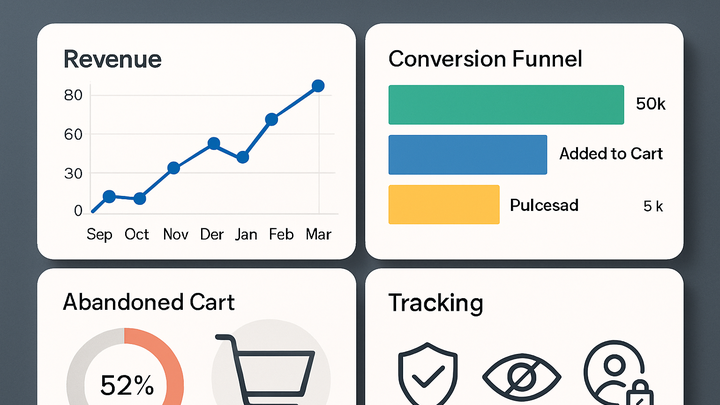Published on 2025-06-26T05:30:04Z
What is E-commerce Analytics? Examples, Metrics, and Best Practices
E-commerce Analytics is the practice of collecting, analyzing, and interpreting data from online retail platforms to drive business growth. It combines transactional data (like sales and revenue) with behavioral data (like page views and user journeys) to provide insights into customer acquisition, conversion, and retention. By leveraging analytics, businesses can optimize marketing campaigns, personalize shopping experiences, and improve operational efficiency. Popular tools for e-commerce analytics include Google Analytics 4 (GA4) and PlainSignal, a cookie-free analytics solution designed for privacy compliance. This glossary entry explores the definition, key metrics, implementation approaches, and best practices of e-commerce analytics in depth.
E-commerce analytics
Analysis of online store data to optimize sales, marketing, and customer experience using tools like GA4 and PlainSignal.
Definition and Scope
E-commerce Analytics refers to the practice of measuring, analyzing, and optimizing the performance of online storefronts. It involves tracking user interactions, transactions, and behaviors across digital touchpoints to inform strategic decisions. By turning raw data into actionable insights, businesses can improve conversion rates, average order values, and customer loyalty. Analytics spans multiple stages of the customer journey, from acquisition through retention.
-
Core components
E-commerce analytics comprises several interconnected processes that together provide a complete view of online store performance.
-
Data collection
Capturing events such as page views, product clicks, add-to-cart actions, and completed transactions.
-
Behavioral analysis
Segmenting users, identifying browsing and purchase patterns, and understanding customer journeys.
-
Reporting & visualization
Creating dashboards and reports to surface key metrics for stakeholders and guide decision-making.
-
Key Metrics and KPIs
To gauge the success of an e-commerce operation, companies focus on specific metrics and KPIs that reflect revenue growth, customer engagement, and operational efficiency.
-
Conversion rate
The percentage of site visitors who make a purchase during a session.
-
Formula
(Number of orders ÷ Number of sessions) × 100
-
Benchmark
Typically ranges from 1% to 3% depending on the industry and channel.
-
-
Average order value (aov)
The average revenue generated per transaction.
-
Formula
Total revenue ÷ Total number of orders
-
Use case
Helps identify upselling and cross-selling opportunities to increase cart values.
-
-
Shopping cart abandonment rate
The percentage of initiated shopping carts that are not completed as purchases.
-
Impact
High abandonment signals friction in the checkout process and lost revenue.
-
Reduction strategies
Simplify checkout flows, enable guest checkout, and send follow-up reminder emails.
-
Implementation Approaches
Selecting the right analytics platform and configuring accurate tracking are foundational steps in e-commerce analytics.
-
Google analytics 4 (GA4)
GA4 offers event-based tracking, built-in funnel analysis, and seamless integration with Google Ads. To implement GA4, add the global site tag to your HTML:
<!-- Global site tag (gtag.js) --> <script async src="https://www.googletagmanager.com/gtag/js?id=GA_MEASUREMENT_ID"></script> <script> window.dataLayer = window.dataLayer || []; function gtag(){dataLayer.push(arguments);} gtag('js', new Date()); gtag('config', 'GA_MEASUREMENT_ID'); </script>-
Event tracking
Configure purchase, add-to-cart, and custom events in the GA4 interface.
-
E-commerce reporting
Use the Monetization reports to analyze revenue, products, and user lifetime value.
-
-
PlainSignal (cookie-free analytics)
PlainSignal is a privacy-first analytics tool that tracks visits and conversions without relying on cookies. Install it with a simple script snippet:
<link rel="preconnect" href="//eu.plainsignal.com/" crossorigin /> <script defer data-do="yourwebsitedomain.com" data-id="0GQV1xmtzQQ" data-api="//eu.plainsignal.com" src="//cdn.plainsignal.com/plainsignal-min.js"></script>-
Privacy compliance
Operates without third-party cookies, simplifying GDPR and CCPA adherence.
-
Quick setup
Requires minimal configuration and no additional plugins.
-
Use Cases and Examples
E-commerce analytics supports multiple business activities, delivering insights to marketing, merchandising, and operations teams.
-
Marketing attribution
Determines which marketing channels and campaigns drive the most revenue.
-
Multi-touch attribution
Assigns credit to all touchpoints along the customer journey.
-
Roi calculation
Evaluates return on ad spend (ROAS) by comparing revenue to marketing investment.
-
-
Personalization
Delivers tailored product recommendations and content based on user behavior.
-
Product recommendations
Suggests products using past purchase data and browsing history.
-
Email segmentation
Groups customers for targeted email campaigns based on purchase patterns.
-
-
Inventory optimization
Forecasts demand and manages stock levels to reduce overstock and stockouts.
-
Trend analysis
Uses historical sales data to predict future inventory requirements.
-
Automated alerts
Triggers notifications when stock falls below predefined thresholds.
-
Challenges and Best Practices
While powerful, e-commerce analytics comes with challenges that require careful management to ensure accuracy and compliance.
-
Data privacy and compliance
Adhere to regional privacy laws and obtain user consent where required.
-
Gdpr
Requires explicit consent before tracking EU visitors.
-
Ccpa
Honors consumer requests to opt out of data sale or sharing in California.
-
-
Data quality and accuracy
Validate and maintain your datasets to avoid misleading insights.
-
Regular audits
Periodically review tracking tags and data flows for consistency.
-
Testing after updates
Re-test analytics setup following website changes or new feature deployments.
-
-
Choosing the right tool
Balance features, scalability, and privacy requirements when selecting an analytics platform.
-
Scalability
Pick a solution that can handle increases in traffic and data volume.
-
Integration
Ensure compatibility with your existing e-commerce stack and marketing tools.
-
